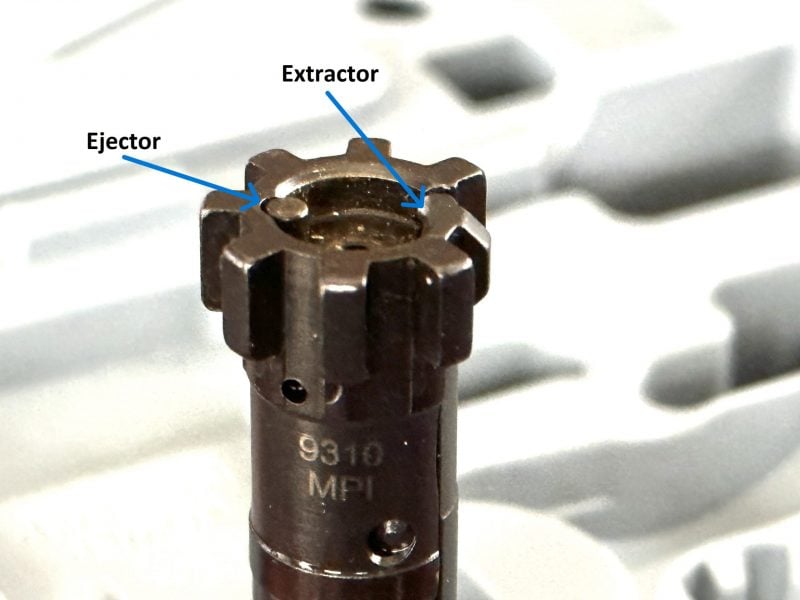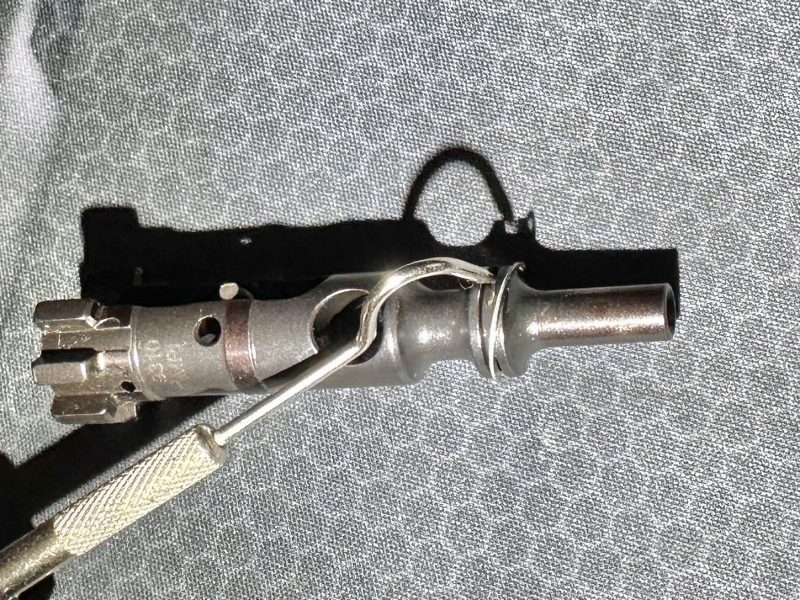In Part 1, we field-stripped the AR-15 BCG and talked about inspecting the parts for wear or damage. So, what happens if you do find a damaged part? It can be replaced. A lot of people never take any parts off the bolt because it is easy to replace the entire bolt or BCG. But a good AR-15 BCG can cost hundreds, and repairing one is a fraction of the price. A BCG is almost always sold as a complete unit. Even when building a rifle from scratch, the AR-15 BCG will come assembled and ready to drop in. But we can keep it running longer by cleaning and maintaining it on a regular basis.

The best tools to use for this part are the Real Avid Master Bench Block, a 3/32 punch, and a 1/16 roll pin punch. A small armorer’s hammer will also be needed. Removing the extractor is not hard to do without the Master Bench Block, but it works like magic on the ejector. These tools can be purchased separately, or they all come with the AR-15 Master Armorers Kit.
Removing the Extractor
The extractor is like a little claw that pops over the edge of the bullet in the chamber and pulls it back out when the round is fired. If the extractor gets broken or worn down, it can stop pulling the spent shell casing out of the chamber. This will cause another bullet to try and feed behind it. When people say their rifle is “double feeding” the real problem is often a failure to extract.

To remove the extractor, lay the bolt in the molded area of the bench block (see photo below). There are two small pins in the bolt. The one on the right (red arrow) is the one for the extractor. The Bench Block has a small cutout in the bottom of it that will allow the pin to fall out as you push the 3/32 punch through it. With the pin out, the extractor will come off. The extractor has a small spring and rubber washer that can be removed if they need to be replaced or cleaned.

There is a small plastic post that helps keep the spring from bending. It may come off in the spring or stay in the extractor. If this spring gets damaged or worn, it could cause the extractor to not have enough force to pull the shell casing out of the chamber. The groove of the extractor tooth is a place that can build up junk and may need to be scraped out.
Removing the Ejector
Now that the extractor is off, we can remove the ejector from the bolt. Just like we did with the extractor, the bolt should be placed in the molded area of the Bench Block with the ejector pin facing up. There is a red handle that turns on the bench block. The bolt should be orientated so that the ejector is pushed in as you turn the handle (see photo below). A 1/16 roll pin punch and a small hammer should be used to tap the pin out.

Once the roll pin is out, unscrew the red handle. The ejector spring will push the ejector part way out so make sure the pressure is all the off the bench block before picking the bolt up. The ejector will be sticking out of the top of the bolt and can be removed, along with the spring under it.

When the extractor starts to pull the bullet casing out of the chamber, the ejector pushes against the casing. There is nowhere for the casing to go until it clears the ejection port. Once it clears, the pressure from the ejector flings the casing out of the gun. If the spring is weak or the ejector gets worn, the casing will not eject properly. If a gun is older and appears to have been fired a lot, I like to replace the whole set. The ejector, spring, and roll pin can be purchased for about $10.
Removing the Gas Rings
The last thing we will remove from the bolt is the gas rings. The gas rings help create a seal as the bolt travels back and forth in the bolt carrier. If the rings get worn out, they can let gas through and may cause cycling issues. To remove the gas rings, I use a gunsmith pick (like the one I pulled the retaining pin out with in Part 1). Just like you take off a tire from a car, I get the pick started under the ring and push one side out. I start with the outside ring first. With one edge out of the grove, you can work your way around the bolt, pushing the ring off as you go (see photo below).

There should be three gas rings in total that need to be removed. Once they are removed the bolt can be cleaned and the rings wiped off or replaced. They go back on the same way they came off. Start one side and work your way around, until it is back in the groove. There is a small gap in each ring. The rings should be turned so that the gaps are not lined up. This will help keep gas from getting past them on the bolt.
Finishing Up
Everything has now been taken off the bolt. It can be thoroughly scrubbed and cleaned if needed and each part can be inspected. I would recommend keeping each part in groups so you don’t get the pins and springs confused. The process of putting them back on is the same as taking them off. I would start with the gas rings, then the ejector. The extractor can go on last and then the bolt is ready to place back in the bolt carrier. Just like building an AR-15, having the knowledge to take the AR-15 BCG completely apart is satisfying and fun. It allows you to maintain your own rifle and keep it running great for years to come.



